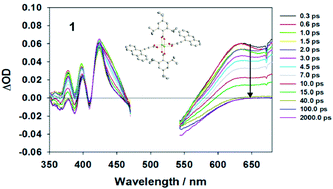Quadruply bonded dinuclear metal complexes of molybdenum and tungsten have the MM configuration σ2π4δ2 and a considerable degree of attention has been devoted to studies of the δ → δ* transition. For compounds of the type M2(O2CR)4, the CO2 π* orbitals introduce a M2 δ to ligand π* transition, a 1MLCT absorption which may be lower in energy than the δ → δ* and is more intense, thus obscuring the observation of the latter. When the R group is a conjugated organic system such as an aryl group, the 1MLCT shifts to even lower energy and emission is seen from this S1 state in addition to phosphorescence from the T1 state which may be either 3MLCT or 3MMδδ*. The latter typically occurs around 1100 nm with a lifetime that ranges from ∼1 μs (M = W) to 100 μs (M = Mo). The S11MLCT states have lifetimes of ∼1–20 ps, allowing for fs and ns studies of the charge distribution/localization with time in both the S1 and T1 states, which is quite rare for transition metal coordination complexes. Of particular interest and focus have been complexes of the type trans-M2L2L′2 where L and L′ are carboxylate or amidinate groups for which only one set of ligands allows for expansive Lπ–M2δ–Lπ conjugation and has a low energy 1MLCT. Compounds of this type have excited states that may be considered as mixed valence (MV) ions [L–M2+–L−] ↔ [L−–M2+–L] where the hole resides on the M2 unit and the electron is either localized on one ligand, a class I or II MV ion, or is fully delocalized over both ligands, a class III ion in the Robin and Day scheme. Examples of these systems will be described along with the newly prepared complexes trans-M2(TiPB)2(O2CC![[triple bond, length as m-dash]](https://www.rsc.org/images/entities/char_e002.gif) C-9-anthracene)2, M = Mo, W, that have the IR-active reporter groups CO2 and C
C-9-anthracene)2, M = Mo, W, that have the IR-active reporter groups CO2 and C![[triple bond, length as m-dash]](https://www.rsc.org/images/entities/char_e002.gif) C.
C.

You have access to this article
 Please wait while we load your content...
Something went wrong. Try again?
Please wait while we load your content...
Something went wrong. Try again?
![[triple bond, length as m-dash]](https://www.rsc.org/images/entities/char_e002.gif) C-9-anthracene)2, M = Mo, W, that have the IR-active reporter groups CO2 and C
C-9-anthracene)2, M = Mo, W, that have the IR-active reporter groups CO2 and C![[triple bond, length as m-dash]](https://www.rsc.org/images/entities/char_e002.gif) C.
C.

 Please wait while we load your content...
Please wait while we load your content...